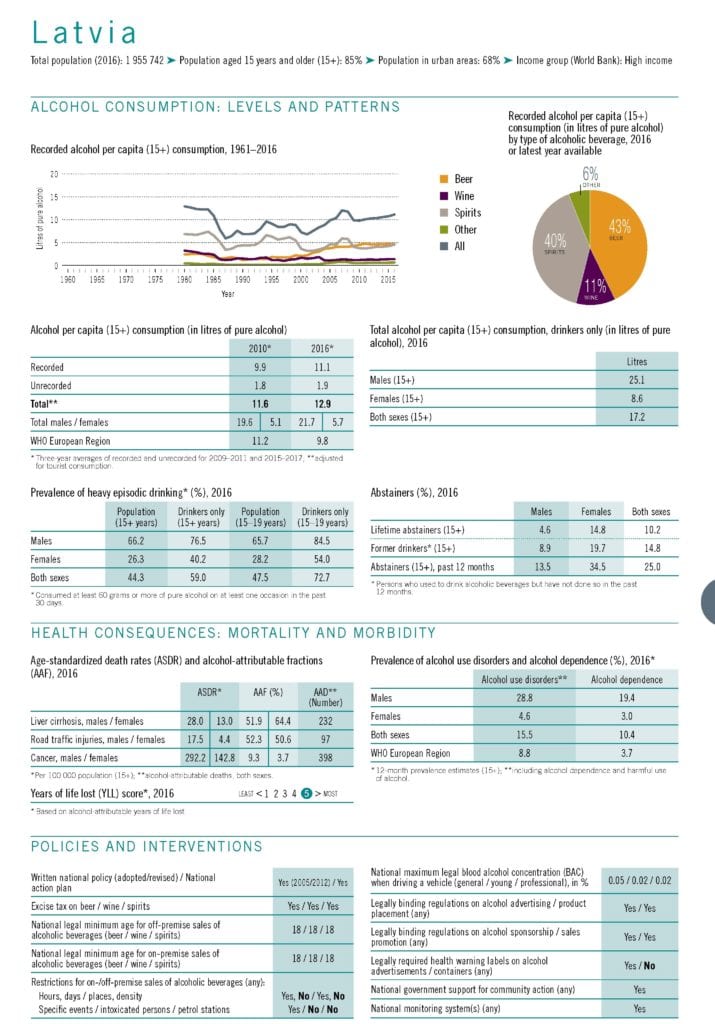Alcohol plays a role in many injuries and emergency situations in Latvia. Many of these injuries end in tragedy with people dying in fires, drowning, or freezing while being intoxicated. The truth is also that many of these tragedies could be averted if alcohol was less available and affordable.
Alcohol is a major risk factor for various injuries, including life-threatening situations. And apart from causing injuries, alcohol intoxication makes it more difficult for emergency and medical staff to provide proper help.
The Latvian Emergency Medical Service (NMPD) reports:
- Of all NMPD calls, about 15% of cases involve a person under the influence of alcohol.
- The statistic is even higher when it comes to injuries.
- One in every three people injured was under the influence of alcohol.
It is very common. In such calls [with injuries] 30% are [under the influence of alcohol]. And very often, alcohol use has been the reason for such an accident,” said Lauma Sproga-Jankoviča NMPD medic as per Public Broadcasting of Latvia.
Yes, if a person is under the influence of intoxicating substances, the consciousness is not clear and the senses are dulled, then they suffer more. Let’s say, in fires. Most often, where someone has burned to death – alcohol has also been there.”
Lauma Sproga-Jankoviča, NMPD medic
Ivo Bendrats, a representative of the State Fire and Rescue Service’s Rīga Regional Administration confirms the presence of alcohol during fire emergencies.
It often seems that the person is under the influence of alcohol,” said Mr Bendrats, as per Public Broadcasting of Latvia.
There have been a lot of cases where [the caller] cannot convey the information properly and exactly, or where there may be a friend or relative, which makes it difficult to save them.”
Ivo Bendrats, representative of the State Fire and Rescue Service, Rīga Regional Administration
While there are no exact statistics regarding alcohol’s role in fires, freezing, and drowning cases in Latvia, frontline workers such as Ms. Sproga-Jankoviča and Mr. Bendrats confirm that it happens and is quite common.
Alcohol’s harm to others, including medical and emergency staff
Trying to save those who are under the influence of alcohol in an emergency can endanger emergency medical staff as well. Recalling an incident where her team had to rescue an ex-boxer who was under the influence of alcohol Ms. Sproga-Jankoviča says “it was a threat to the medics themselves.”
Alcohol harm increases the burden on NMPD’s specialized medical center as well. Neurosurgeon Dmitrijs Gavriļins says those who are being admitted under the influence of alcohol don’t actually know what has happened to them and what is wrong with them, making it difficult to help them and leading to unnecessary and costly procedures, such as CT scans, just to eliminate risks.
Employees of the Latvian medical and emergency services see the Latvian alcohol problem first-hand, everyday in their work.
Pervasive alcohol harm in Latvia
Not only in injuries and emergencies, the Latvian alcohol problems are affecting the mental health of children and young people as well. As Movendi International previously reported, during the pandemic several coinciding and interrelated problems were rising in Latvia. These include the use of alcohol and other harmful substances, mental health problems among children and adults, unemployment, and violence.
Alcohol harm and policy in Latvia
But implementing alcohol policy solutions would help reduce the widespread alcohol harm in the country.
As the World Health Organization (WHO) reports, total per capita alcohol consumption in Latvia is 12.9 liters – high above the average of the WHO European region, the heaviest alcohol-consuming region in the world. Over half (59%) of alcohol users above 15 years of age and over two-thirds (72.7%) of alcohol-using youth between 15 to 19 years engage in binge alcohol consumption.
One alcohol policy measure that Latvia can implement is improving alcohol taxation in the country. As a Baltic nation, one of Latvia’s major concerns when implementing alcohol tax increases is cross-border trade. Movendi international has been reporting on the situation between Estonia and Latvia where the countries were competing to reduce taxes citing cross-border trade issues. Initially, in 2019 Estonia reduced its alcohol tax by 25%. In response, Latvia decided to limit its planned 30% tax increase to only 5% in order to keep the prices of alcohol cheaper than in Estonia.
But raising alcohol excise taxes is a WHO recommended alcohol policy best buy solution which is proven effective in preventing and reducing alcohol harm cost-effectively. Latvia has the opportunity to learn from neighboring Estonia and Lithuania and collaborate with its neighbors to unlock public health and safety benefits of alcohol policy solutions.
As policies of one country affect neighbors in close-knit regions such as the Baltics, it is imperative that the countries collaborate across borders. With a coordinated plan the entire region can benefit from the prevention and reduction of alcohol harm, improved health, safety and economic productivity.
